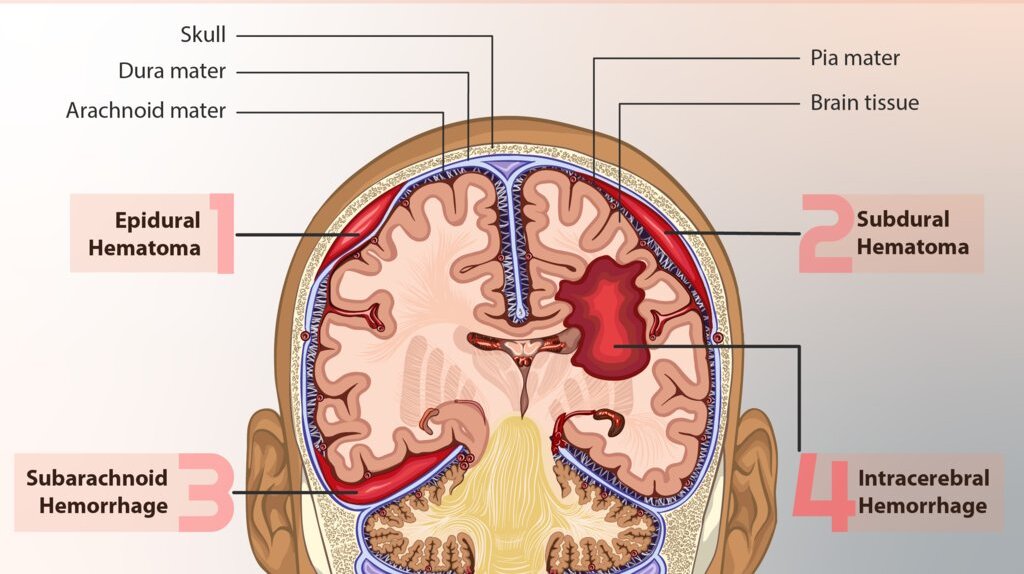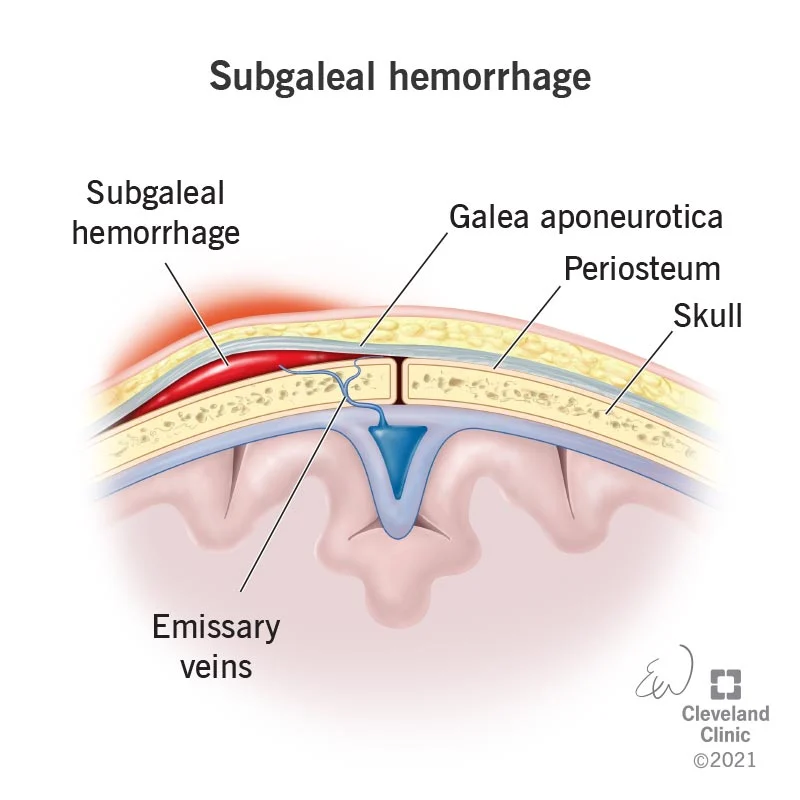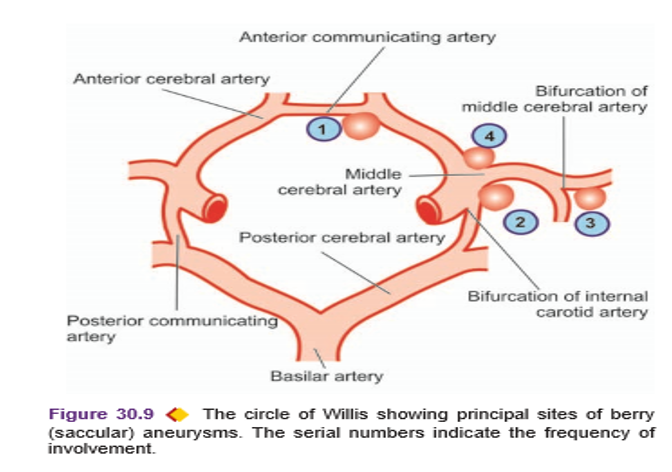Table of Contents
ToggleIntracranial Hemorrhage
An intracranial hemorrhage is a type of bleeding that occurs inside the skull (cranium).
Hemorrhages that occur within the skull or brain generally happen suddenly, from either external or internal causes. A hemorrhage can rapidly cause brain damage and can be life-threatening.
Bleeding around or within the brain itself is known as a cerebral hemorrhage (or intracerebral hemorrhage). Bleeding caused by a blood vessel in the brain that has leaked or ruptured is called a hemorrhagic stroke.
All bleeding within the skull is referred to as intracranial hemorrhage.
Causes of Intracranial Hemorrhage.
- Head trauma, such as that caused by a fall, car accident, sports accident, epilepsy etc
- Hypertension (high blood pressure) damage to blood vessel walls that causes the blood vessel to leak or break
- Blockage of an artery in the brain by a blood clot that form in the brain or travel to the brain from another part of the body.
- Ruptured cerebral aneurysm (a weak spot in a blood vessel wall that balloons out and bursts)
- Leaking of malformed arteries or veins.
- Bleeding tumors
- Conditions related to pregnancy or childbirth, including eclampsia
- Difficult delivery e.g. obstructed labor
- Assisted delivery
- Coagulopathy or anti coagulation medicine e.g. warfarin, heparin, bleeding disorders like hemophilia, thrombocytopenia
- Child abuse syndrome (shaken baby syndrome)
- Postsurgical (craniotomy, shunting)
Pathophysiology
Since the brain cannot store oxygen, it relies upon a series of blood vessels to supply oxygen and nutrients. When a hemorrhage occurs, oxygen may no longer be able to reach brain tissue supplied by leaky or broken blood vessels. Pooling of blood from an intracranial hemorrhage or cerebral hemorrhage also puts pressure on the brain and deprives it of oxygen.
When a hemorrhage or stroke interrupts blood flow around or inside the brain, depriving it of oxygen for more than three or four minutes, the brain cells die. The affected nerve cells and the related functions they control are damaged as well.
Types of Intracranial Hemorrhage
- Epidural hematoma
- Subdural hematoma
- Subarachnoid hemorrhage
- Intra cerebral hemorrhage

Epidural Hematoma (Subgalea hemorrhage)
Subgaleal hemorrhage occurs when the emissary veins between the skull and the intracranial venous sinuses are sheared or torn, and blood collects in between the apo-neurosis and the periosteum of the skull. It typically follows a head injury, and usually with a skull fracture. High-pressure bleeding is a prominent feature. An epidural hematoma, may briefly lead to lose consciousness and then consciousness is regained latter.
Epidural hematoma is accumulation of blood between the Dura and the skull following fracture of the skull
- Most commonly from rupture of middle meningeal artery.
- The hematoma expands rapidly since accumulating blood is arterial in origin and causes compression of the Dura and flattening of underlying gyri
- The patient develops progressive loss of consciousness if hematoma is not drained early.
Signs and symptoms
- Swelling of the ears
- Increasing head circumference as bleeding expands into this space. (hydrocephalus)
- Hypovolemic shock,
- Tachycardia,
- Hypotension
Diagnosis
- Subgaleal hemorrhage may present as a large, boggy fluid collection palpable on the head’s surface. Characteristic of a subgaleal hemorrhage is that it is not restricted by suture lines and may shift with movement. This is in contrast to the more common cephalohematoma, a superficial collection of blood restricted to the space between the periosteum and skull, which is contained along suture lines.
Neonates with subgaleal hemorrhage are at high risk for rapid decompensation; the subgaleal space can expand to collect a newborn’s entire intravascular blood volume if bleeding continues unrecognized.

Subdural hematoma (SDH)
A subdural hemorrhage occurs when bridging veins carrying blood through the dura mater to the arachnoid mater of the meninges are torn. This causes bleeding, with blood collecting below the dura and superior to the subarachnoid villi
SDH is a collection of blood below the inner layer of the duramata but external to the arachnoid membrane.
- Subdural hematoma is accumulation of blood between the Dura and subarachnoid.
- Develops most often from rupture of veins which cross the surface convexities of the cerebral hemispheres.
Subdural hematoma may be acute or chronic.
- Acute subdural hematoma; develops following trauma and consists of clotted blood, often in the front parietal region. There is no significant compression of gyri. Since the accumulated blood is of venous origin, symptoms appear slowly and may become chronic with passage of time if not fatal.
Chronic subdural hematoma; occurs often with brain atrophy. Chronic subdural hematoma is composed of liquid blood. Separating the hematoma from underlying brain is a membrane composed of granulation tissue.
Diagnosis
- Because subdural bleeders are located within the skull, there is often no physical sign on the scalp that reflects injury. Instead, the presence of hemorrhage may initially be unrecognized. For most neonates, subdural hemorrhage remains asymptomatic and resolves without consequence.
- Clinical problems can arise in case of large volume hemorrhage or if bleeding slowly continues over hours or even days, as in cases of bleeding disorders.
- Symptomatic neonates often present 24–48 hours after birth with nonspecific signs such as apnea, respiratory distress, altered neurologic state, or seizures.
Subarachnoid hemorrhage
Subarachnoid hemorrhage occurs when the veins of the subarachnoid villi are torn, leading to a collection of blood in the subarachnoid space. There’s bleeding between the brain and the thin tissues that cover the brain. These tissues are called meninges.
A sudden, sharp headache usually comes before a subarachnoid hemorrhage. Typical symptoms also include loss of consciousness and vomiting.
- Hemorrhage into the subarachnoid space is most common, caused by;
- rupture of an aneurysm, and rarely, rupture of a vascular malformation.
- Of the three types of aneurysms affecting the larger intracranial arteries—berry, mycotic and fusiform, berry aneurysms are most important and most common.
- Berry aneurysms are saccular in appearance with rounded or lobulated bulge arising at the bifurcation of intracranial arteries and varying in size from 2 mm to 2 cm or more.
- They account for 95% of aneurysms which are liable to rupture.
- Berry aneurysms are rare in childhood but increase in frequency in young adults and middle life.
- They are, therefore, not congenital anomalies but develop over the years from developmental defect of the media of the arterial wall at the bifurcation of arteries forming thin-walled saccular bulges.
- Although most berry aneurysms are sporadic in occurrence, there is an increased incidence of their presence in association with congenital polycystic kidney disease and coarctation of the aorta.
- In more than 85% cases of subarachnoid hemorrhage, the cause is massive and sudden bleeding from a berry aneurysm on or near the circle of Willis.
The four most common sites are;
- In relation to anterior communicating artery.
- At the origin of the posterior communicating artery from the stem of the internal carotid artery.
- At the first major bifurcation of the middle cerebral artery.
- At the bifurcation of the internal carotid into the middle and anterior cerebral arteries

Intracerebral hemorrhage
Intra cerebral hemorrhage is when there’s bleeding inside the brain.
This is bleeding into the brain’s ventricular system, where the cerebrospinal fluid is produced and circulates through towards the subarachnoid space. It can result from physical trauma or from hemorrhaging in stroke ( HTN). This is the most common type of ICH that occurs with a stroke. It’s not usually the result of injury.
- Spontaneous intracerebral hemorrhage occurs mostly in patients of hypertension. Children with systemic diseases that manifest with HTN are at risk because they have micro aneurysms in very small cerebral arteries in the brain tissue.
- Rupture of one of the numerous micro aneurysms is believed to be the cause of intracerebral hemorrhage
- Not common to have recurrent intracerebral hemorrhages like is the case of subarachnoid hemorrhages
- The common sites of hypertensive intracerebral hemorrhage are the region of the basal ganglia (particularly the putamen and the internal capsule), pons and the cerebellar cortex
Diagnosis
- There are very few clinical symptoms of IcH. When present, signs may include an acute drop in hematocrit, new-onset hypotension, and lethargy.
- However, these symptoms are often present in extremely low birth weight and prematures
Signs and Symptoms
A prominent warning sign is the sudden onset of neurological deficit. This is a problem with the brain’s functioning. The symptoms progress over minutes to hours and they include:
- Headache accompanied by neck stiffness
- Drowsiness
- Difficulty speaking/crying
- Nausea
- Vomiting
- Decreased consciousness
- Seizure
- Coma
- Weakness in one part of the body
- Elevated blood pressure
- Cognitive dysfunction or memory loss
- Sudden tingling, weakness, numbness, or paralysis of the face, arm or leg, particularly on one side of the body
- Loss of balance or coordination in older children
- Babies less than 12 months old may develop a swollen fontanel, or soft spot
Diagnosis
- History taking
- Computed temography (CT- scan) of head
- MRI of head
- CBC
- Coagulation profile e.g. INR, PT
Physical examination e.g. glasgow coma scale (GCS):
- Eye Opening
- Verbal response
- Best motor response
| 1 | 2 | 3 | 4 | 5 | 6 | |
|---|---|---|---|---|---|---|
| Motor response | None | Extensor | Abnormal Flexion | Normal Flexion | Localizes pain | Obeys command. |
| Verbal response | None | Incomprehensible sounds | Inappropriate word | Confusion | Spontaneous / Oriented | |
| Eye opening | None | To pain | To command/ speech | Spontaneous |
Glasgow Coma Scale.
Management
- Admission in icu or surgical paediatric ward
- Resuscitation (ABC); All patients with GCS < 8 should be intubated for airway protection
- Surgical management
ICH is a medical emergency. Survival depends on getting treatment right away. It may be necessary to operate to relieve the pressure on the skull (craniotomy)
- Craniotomy; to evacuate blood
- Endovascular treatment; to occlude parent artery
- Aneurysm coiling; obstruct aneurysm site with coil
Medical management
- Steroids to reduce swelling
- Anticoagulants to reduce clotting
- Ant seizure medications
- Medications to counteract any blood thinners that you’ve been taking
- Lower blood pressure to a mean arterial pressure less than 130 mm Hg, but avoid excessive hypotension
- Avoid hyperthermia.
- Correct any identifiable coagulopathy with fresh frozen plasma, vitamin K, or platelet transfusions.
- Lower blood pressure to a mean arterial pressure less than 130 mm Hg, but avoid excessive hypotension
- Avoid hyperthermia.
- Correct any identifiable coagulopathy with fresh frozen plasma, vitamin K, or platelet transfusions.
- Initiate anticonvulsant definitely to control seizures
- Facilitate transfer to the operating room or ICU.
- Consider nonsurgical management for patients with minimal neurological deficits
Diet
- Employ aspiration precautions and obtain evaluation of patient’s swallowing.
- Initiate enteral feedings as soon as possible. The patient may require placement of a nasogastric tube or percutaneous device.
Activity
- Maintain bed rest during the first 24 hours.
- Follow with progressive increase in activity.
- Avoid strenuous exercise
Complications.
- Seizures
- Paralysis
- Memory loss
- Stroke
- Permanent brain damage
- Cerebral coning
- Depression
- Bedsore

